
Persepolis, also known as Takht-e Jamshīd in Persian, is a remarkable testament to ancient Iranian history. Located in the Fars Province near Marvdasht, this city was founded by Cyrus the Great.
Throughout its history, Persepolis grew and evolved under the patronage of Achaemenid monarchs like Xerxes and Ardeshir I, becoming the capital of the Achaemenid Empire and exemplifying the grandeur of ancient Iran.

In the post-Achaemenid era, the decline of the ancient Persian script and language, along with indecipherable inscriptions, led to the gradual abandonment of the name “Pārsa.” Instead, the city became commonly known as “Takht-e Jamshid,” associated with a legendary prehistoric king. Situated within the ancient city of Pārsa, Takht-e Jamshid retained its role as the enduring ceremonial capital of the Achaemenid Empire for about two centuries.
On the first day of the New Year, representatives from various regions and satrapies gathered at Takht-e Jamshid, each bearing diverse offerings. These envoys presented their gifts to the reigning monarch, symbolizing unwavering loyalty and tribute to the Achaemenid Empire.

Contents
Where is Persepolis and how far is it from Shiraz?
Persepolis lies within Iran’s Fars Province, approximately 57 kilometers from Shiraz. To reach Persepolis, you must journey to the Fars Province and Marvdasht county.
The archaeological site of Persepolis is situated approximately 10 kilometers to the north of Marvdasht, resting in the foothills of a mountain previously referred to as “Rahmat,” known by other names like “Mitra” and “Mehr.”
Persepolis was built upon an elevated platform, standing 8 to 18 meters above the Marvdasht plain. The site comprises distinct sections, encompassing ceremonial palaces, smaller private palaces, the royal treasury, and defensive fortifications, including protective walls.
Where does the name Persepolis come from?
The name “Persepolis” finds its roots in the original appellation of the ancient city, “Parse.” This name was derived from the presence of the Pars people who inhabited the region during the Achaemenid Empire. Later, the Greeks adopted names such as “Persepolis,” which meant “The city of Pars.” During the Sassanid era, it was commonly known as “Hundred Columns.”

Over the course of different historical periods, this architectural wonder was known by different names, such as “Forty Minarets” or “Takht-e Hazrat-e Soleymān.” Centuries later, as the Achaemenid era became less prominent and the cuneiform inscriptions on the tablets became unreadable, the site became linked with the legendary “Throne of Jamshid” mentioned in the Shahnameh. This association ultimately led to its recognition as “Persepolis.”
Scholars suggest that during the Sassanid era, the name “Jamshid” became linked to this edifice. In later years, European academics recognized that “Persepolis,” as mentioned by the renowned Greek historian Herodotus, referred to the same site.
It is worth noting that Jamshid was a legendary Iranian king who held a special place in the hearts of his contemporaries. “Persepolis” has been recognized as a UNESCO World Heritage Site since 1979, underscoring its profound historical and cultural significance.
History of Persepolis
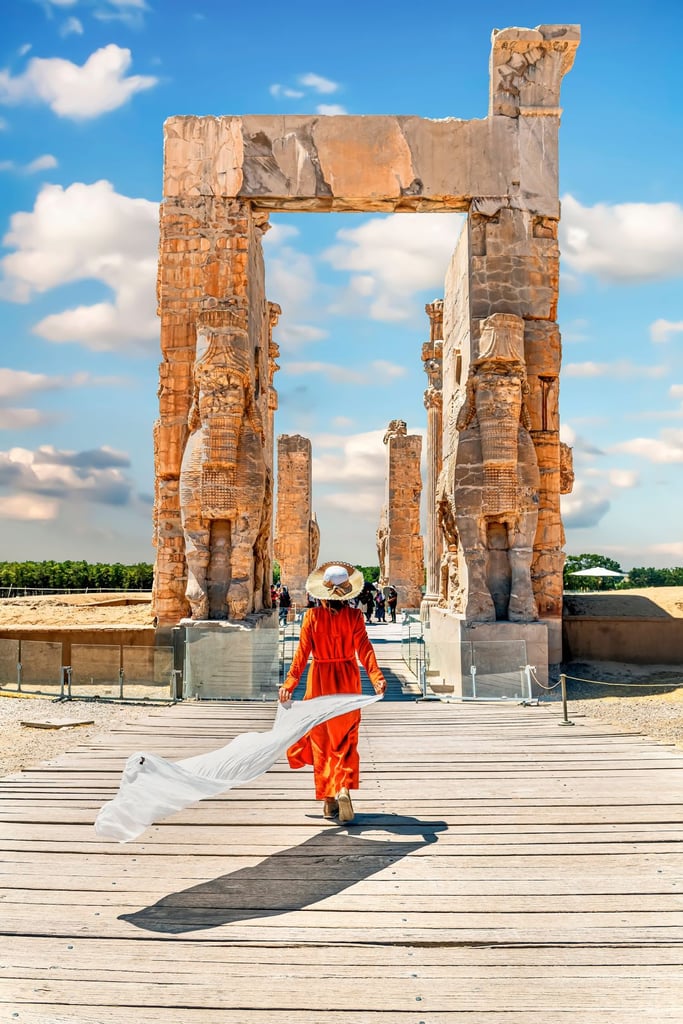
The history of Persepolis offers a captivating journey into the ancient past. Historical records indicate that the construction of this grand and historic structure commenced around 500 years before the birth of Christ, following the orders of Cyrus the Great.
It took approximately 150 years (or, according to some accounts, 120 years) to complete. Notably, Xerxes and Artaxerxes I, the son and grandson of Darius the Great, played pivotal roles in expanding this ancient city, adding numerous buildings and grand structures to the original complex. Some researchers even suggest that Persepolis continued to grow and develop until the end of Achaemenid rule.
One of Persepolis’s most striking features is its vast expanse, encompassing nearly 125,000 square meters, adorned with inscriptions, sculptures, and ancient artifacts that offer profound insights into Iran’s rich history. Furthermore, the complex’s exceptional architecture highlights the remarkable skills and artistry of Iranian architects.
Interestingly, in the design of this complex, one can discern the influences of various cultures, including the Medes, Babylonians, Greeks, and Egyptians, all of whom, at some point in history, fell under the dominion of the Achaemenid Empire.

Darius the Great harbored a singular ambition when embarking on the construction of this complex: to establish an unparalleled capital within his empire. Fortunately, he achieved this ambitious goal. Notably, historical evidence suggests a marked contrast with the practices of Egyptian pharaohs, who relied on slaves and forced labor. Darius, in contrast, regarded the individuals and artisans engaged in constructing Persepolis as skilled workers rather than mere slaves.
In fact, the discovery of clay bricks in the northern section of Persepolis dating back to 1312 BCE provides compelling evidence that all those involved in building this remarkable complex, including architects, educators, carpenters, stonecutters, and construction laborers, were afforded labor rights and worker insurance. This serves as a testament to the enlightened rule of Darius.
Who set Persepolis on fire?
Among the historical books and narratives about the fate of Persepolis, one name remains constant – Alexander the Great. In my opinion, anyone whose name is often on people’s lips isn’t always to blame for events. Many times, one must seek clues that accompany a person’s actions.
The story of Alexander and Persepolis is no different. Regarding the burning of Iran’s capital during the time of the Achaemenids after its conquest, we cannot solely blame the behavior of King Xerxes after the conquest of Greek cities. Nor can we overlook the role of Alexander’s companions, as historical records suggest that Alexander himself had an affinity for Iranian culture and conditions.
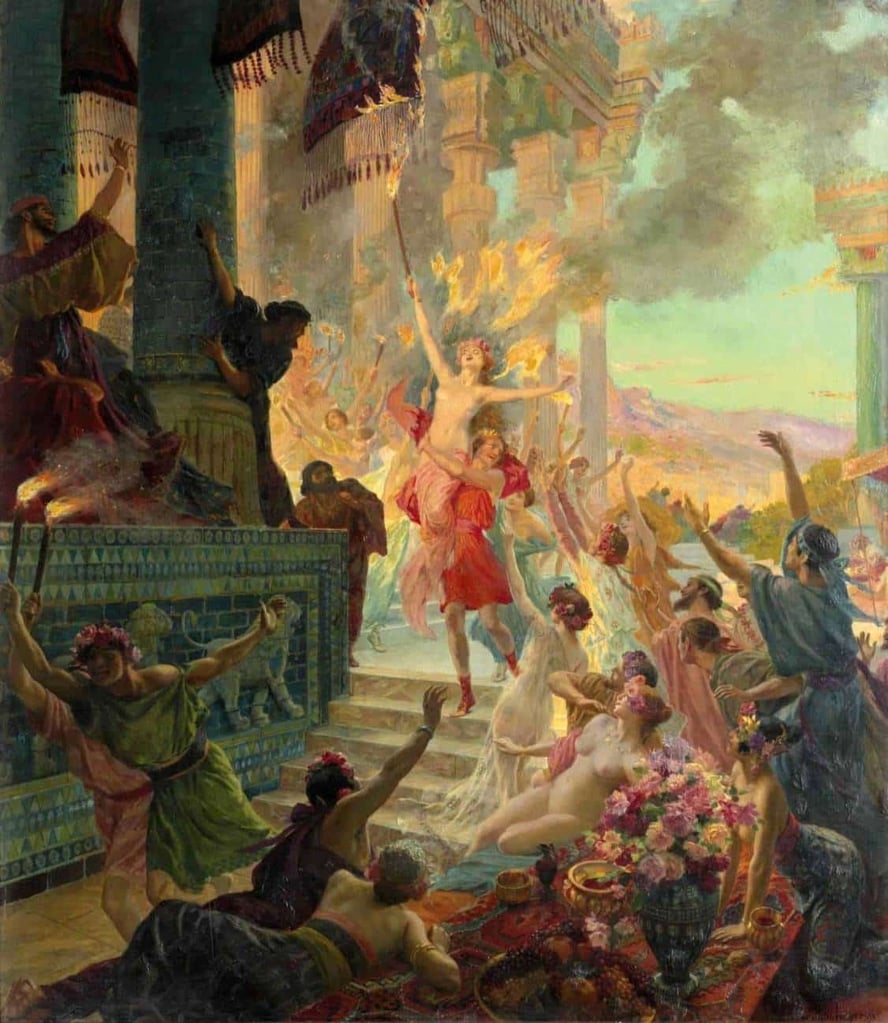
However, there are a few names and historical circumstances that can be mentioned as those responsible for setting Persepolis on fire. It’s worth noting that many historians believe the fire may have been the result of an accident. Nevertheless, these are historical theories, and there’s often no definitive evidence to favor one over the other.
The first person is Alexander himself because, regardless of the circumstances, he issued the order for its destruction. Another individual is his companion or lover who is mentioned in history as someone insistent on the fire. One event that potentially led to the order to burn Persepolis was the captivity of Greek soldiers by the Iranians, preventing them from escaping.
It’s worth mentioning that any event that led to the destruction of Persepolis is ultimately less important than the invaluable artifacts and writings that were lost in the aftermath. What’s crucial is that these artifacts and manuscripts could have shed light on one of the most significant periods in Iranian history, regardless of the circumstances surrounding their destruction.
BOOK ONLINE
Shiraz Hotels
Persepolis Before its Destruction
Persepolis, before its destruction, hosted various palaces and buildings, each designed for specific purposes. Historical sources even mention that during that era, there were special accommodations for each season, and Persepolis served as the spring residence of the Achaemenid kings.
During the Achaemenid rule, many kings resided at the throne of Persepolis. The reign of Darius the Great lasted for 36 years. After him, other individuals, including Xerxes, Artaxerxes I, Darius II, Artaxerxes II, Artaxerxes III, and Darius III, ruled over Pārsa (Persia).
During the years 499 to 449 BCE, a significant war took place between the Iranians and Greeks. Finally, in 330 BCE, Alexander the Great, with his army, invaded Persepolis and set it on fire, bringing an end to the prosperous Achaemenid rule.
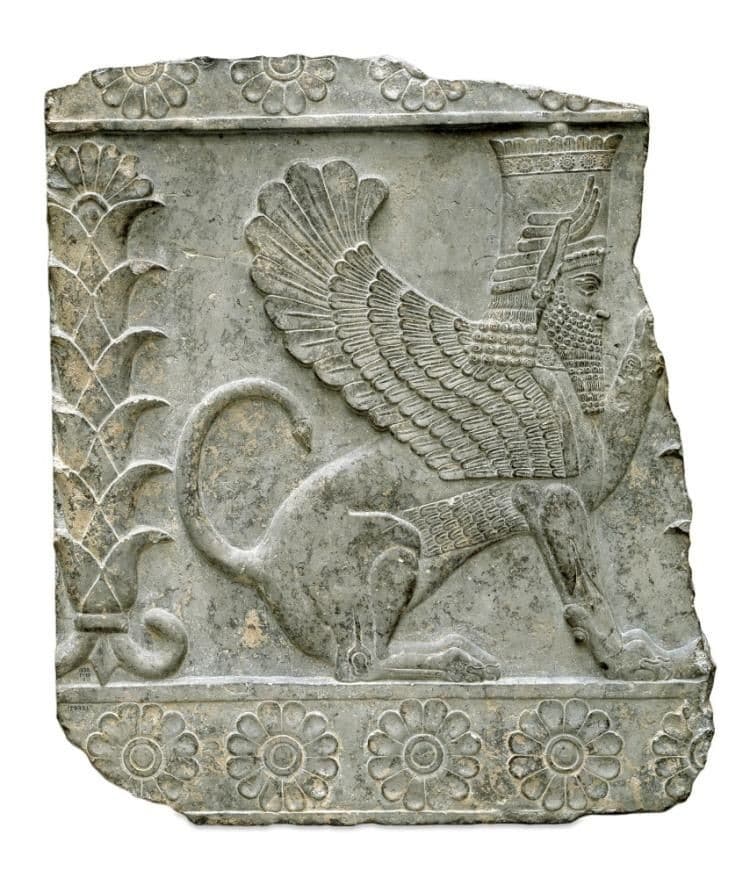
Indeed, there are various narratives and theories surrounding the reasons for Alexander the Great’s attack on Persepolis. Some propose that he may have sought to humble the Iranians due to the belief that the order to attack Greece had originated from Persepolis, also known as Pārsa. Another narrative suggests that the burning of Persepolis may have been connected to Alexander’s personal motivations or influences from his inner circle.
As you’ve mentioned, the lack of clear images or photographs from ancient times makes it challenging to confirm the exact events and motivations. However, historical researchers often rely on ancient texts, accounts, and visual representations to piece together the puzzle of the past.
One such visual source is a painting created by the Dutch designer Cornelis de Bruijn. This painting, produced between November 1704 and January 1705 CE, is considered one of the oldest and most precise depictions of Persepolis available. It provides valuable insights into the appearance of the ancient city and aids in understanding its historical significance.
Different Sections of Persepolis

Now that you are familiar with the history of Persepolis, let us introduce you to its various sections and marvels.
What is the total area of Persepolis?
Persepolis encompasses a substantial area and is indeed one of the largest historical complexes globally. The observable evidence suggests that the total area, including all buildings and the surrounding grounds of Persepolis, is approximately 4 hectares. This translates to roughly 125,000 square meters.
In the subsequent sections, we will delve into explanations and details regarding the various components and parts of Persepolis.
Entrance Staircase and Gate of All Nations
In the northwestern section of Persepolis, two rows of 111 wide and low steps (10 centimeters in height) face each other, which will undoubtedly mesmerize you from the very beginning.
Regarding the low height of these steps, there are various speculations, although none of them can be confirmed 100%.
Some believe that these steps were designed for the ease of movement of horses, while some historians argue that the low height of the steps was meant to preserve the grandeur of the guests whose images could be seen on the walls of Persepolis dressed in luxurious and valuable clothing.

After ascending the 111 steps and observing various inscriptions, you arrive at the “Gate of All Nations,” also known by other names like the “Great Gate” and the “Gate of Xerxes.” The Gate of All Nations stands at a height of 10 meters, and although a significant part of it has now been destroyed, it appears to have had one entrance and two exits. What stands out here more than anything else is the relief carvings of winged men and human-headed bulls on the gates. There are many descriptions regarding these reliefs, some of which are quite remarkable. After passing through the Gate of All Nations, you will enter the Grand Hall of Apadana.
Apadana Palace (Grand Audience Hall)
Apadana is one of the oldest palaces in Persepolis and the largest structure in this historical complex. Its construction was ordered by Darius the Great to host New Year’s celebrations and receive representatives from other countries. The area of the Apadana Palace covers 12,000 square meters, and according to available evidence, there were 72 stone columns scattered around the palace. Today, only 14 columns out of the total 72 remain standing, and it seems that many parts were destroyed due to a devastating fire.

Although people mostly know this palace by the name “Apadana,” there is no mention of such a name in any of the inscriptions discovered in the hall. Therefore, it might be better to introduce this grand complex as the “Grand Audience Hall of Bara’am.”
The Palace of a Hundred Columns
However, one of the most magnificent and grand structures of Persepolis that will undoubtedly amaze you is the Palace of a Hundred Columns, covering an area of approximately 4,300 square meters. In the central hall of this palace, 100 columns, each 14 meters high, were used to support the ceiling, which is why it is referred to as the “largest roofed hall in the world.”

In terms of size, the Palace of a Hundred Columns is considered the second-largest palace in Persepolis, and according to Professor Herzfeld’s research, its construction began during the time of Xerxes and was completed during the reign of Artaxerxes I.
Tachar Palace
Tachar, or “Tachra,” is the name of Darius the Great’s private palace located in the southwestern part of Apadana. It measures 40 meters in length and 30 meters in width. Researchers have found an inscription that reads, “I, Darius, built this Tachar.” Tachar is also known as the “Inscription Palace” because many inscriptions from the Achaemenid period to the Qajar era can be found here, each telling a separate and exciting story.

The palace is constructed on a raised platform with an elevation of 2.4 meters, and in its center, there is a room measuring 15 meters on each side for the king. Once again, reliefs and paintings on the walls will captivate you, from prominent reliefs depicting the king and his two attendants to prominent reliefs on the staircase of servants and mirror-smooth stones. Due to the polished and smooth stones of this palace, some also refer to it as the “Mirror Palace.”
Although “Tachar” means “winter house,” there is no evidence to suggest that Darius spent winters in this palace. It is worth noting that after the construction of the main palace by Darius, the southern stone portico and staircase were built by Xerxes, and the western stone staircase was completed by Artaxerxes II.
Palace H (Hadiš)

In the western part of the Hadiš Palace and southwest of the Throne Platform, you can find a palace known as “H” or “Hadiš.” Unfortunately, many parts of it are now in ruins. Research indicates that Hadiš Palace was ordered to be built by Xerxes, and after that, it was completed by Artaxerxes I. On the staircase of this palace, you can observe two groups of 16 Persian spearmen, as well as ancient inscriptions, although many of them have been significantly damaged.
Hadiš Palace
In the southernmost and highest part of the Persepolis terrace, you can find a palace named “Hadiš,” which was dedicated to King Xerxes. Hadiš is a rectangular palace with an area of approximately 2,200 square meters and featured 36 columns in its main hall. Additionally, the palace has two sets of staircases leading to the Queen’s Palace.
Hadiš means “elevated,” and since King Xerxes had a second wife with the same name, the palace was named Hadiš. Although some scholars believe this palace was built during Darius’s time, the inscriptions and stone carvings found in the palace suggest that it was built by Xerxes. Hadiš Palace is one of the locations that suffered the most damage in the fire, and the yellow color of the stones indicates that they lost their moisture due to the extremely high temperatures. Some believe that the fire may have started from this palace.
The Queen’s Palace

Near the Hadiš Palace, there is a palace known as the “Queen’s Palace,” which was built by Xerxes and is situated at a lower elevation compared to other structures in Persepolis. Professor Herzfeld, who excavated and reconstructed parts of this palace in 1931, speculates that the Queen’s Palace may have served as the harem of King Xerxes due to its thick walls and a single entrance and exit. It’s worth noting that today, a part of this palace is used as a museum and the central facilities management of Persepolis.
The Triple-Gated Palace (Council Hall)
The central palace, known as the Triple-Gated Palace or Council Hall, is a four-sided structure with three entrances and several corridors connecting various parts of Persepolis. If you pay attention to the paintings on the walls and the staircase of this palace, you will see figures casually approaching the ruler. This has led to the palace being known as the “Council Hall.”

The central hall is a completely square structure with walls measuring 15.5 meters and four stone columns. Although many parts of this palace are now in ruins, evidence suggests that the king entered the hall through the eastern gate.
The northern gate of the palace leads us to the Apadana courtyard, while the southern gate allows entry into a small secluded courtyard and then to the Hadiš Palace. We recommend that you do not overlook the stone carvings on these stairs, as they hold many secrets.
It’s interesting to note that in this palace, there are two columns with human heads (a symbol of intellect), which is not seen in the rest of Persepolis.

Palace G
Another important building located in the vicinity of the Hadiš Palace is Palace G. Although many parts of this palace are now in ruins, the remnants of a tall structure, apparently built on the stone foundation of a mountain, will likely capture your attention. On the southern wall of this historic building, you can see images of soldiers and servants who seem to have been brought to Darius’s palace.
The Half-Triple Gate
One of the most important structures in Persepolis is the Half-Triple Gate. This grand gate bears a striking resemblance to the Gate of All Nations and has two rooms in its eastern and western sections, likely intended for the accommodation of guards. Studies also suggest that the architects intended to construct this gate in the shape of a load-bearing ox, making it the largest structure in the complex. Unfortunately, with Alexander’s attack on Persepolis and its subsequent destruction, the construction of this gate was never completed.
The Royal Treasury Building
Another significant and valuable section in this vast complex of 125,000 square meters is the Royal Treasury Building, said to have been commissioned by Darius the Great. The treasury covers an area of approximately 10,400 square meters and contains two magnificent and large halls with 99 and 100 columns, along with several rooms, corridors, and open courtyards.
The clay tablets discovered by Professor Schmidt in the Royal Treasury Building contain incredibly valuable information regarding workers’ rights and how their wages were paid, all inscribed in the Elamite language.
Tomb of Artaxerxes II and Artaxerxes III

In addition to the important buildings and various palaces, the tombs of Artaxerxes II and Artaxerxes III are also situated on Mount Rahmat, facing Persepolis. A cross with four equal arms is used as the symbol on these tombs, each of which has its own distinct meaning and is identified by specific symbols.
How Were the Columns of Persepolis Built?

There have been many strange and far-fetched theories about how the columns of Persepolis were constructed. However, the widely accepted theory among historians is the use of wooden cranes. It is believed that the columns were shaped in areas other than Persepolis and then transported to the site using wooden cranes and rollers.
For example, once about 10 gates or columns were ready, they were transported with the assistance of wooden cranes and pivot rollers. It is important to note that neither giants nor angels were involved in building this structure; instead, Persepolis and its columns were constructed and engineered using the technology and expertise of the architects of that time. One of the most important incomplete structures, which provides evidence of the use of cranes, is the Half-Triple Gate in the Persepolis complex.
Underground Water Channels
Another wonder of Persepolis relates to its underground water channels, a specialized network designed as a sewage system under various buildings to quickly and efficiently drain rainwater from the streets and courtyards, preventing damage to the main structures.

Apparently, the collection point for this water was located in the foothills of Mount Rahmat, where channels were used to store and utilize water as needed, including for defensive purposes. The construction of this sewage network showcases the skill and architectural finesse of ancient Iranian engineers thousands of years ago.
Persepolis Museum
The Queen’s Palace, which was originally the harem of Xerxes, has now been transformed into a beautiful museum where you can see many cuneiform inscriptions, clay tablets, and other historical artifacts discovered during research in this area.
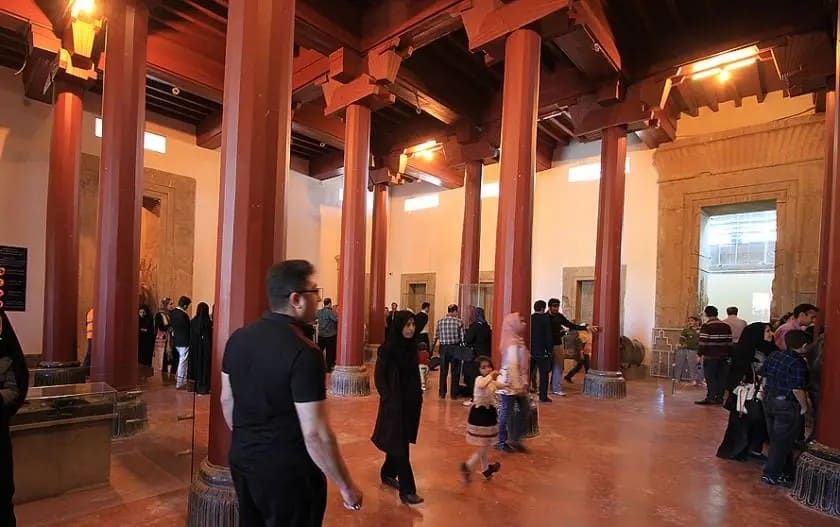
It is one of the oldest structures in Iran that has been converted into a museum and can provide you with a fascinating experience. Artifacts from the Achaemenid era, inscriptions in cuneiform script, scorched curtains from Persepolis, and the famous cuneiform inscriptions of Xerxes, known as the Xerxes’ Edict, are some of the most valuable treasures that can be found in the Persepolis Museum.
Reconstruction of Persepolis
Over the past century, many individuals have made efforts to restore and preserve Persepolis as a national and global heritage site. The first attempts were made in the early years, with some kings attempting to repair certain palaces to prevent their destruction.
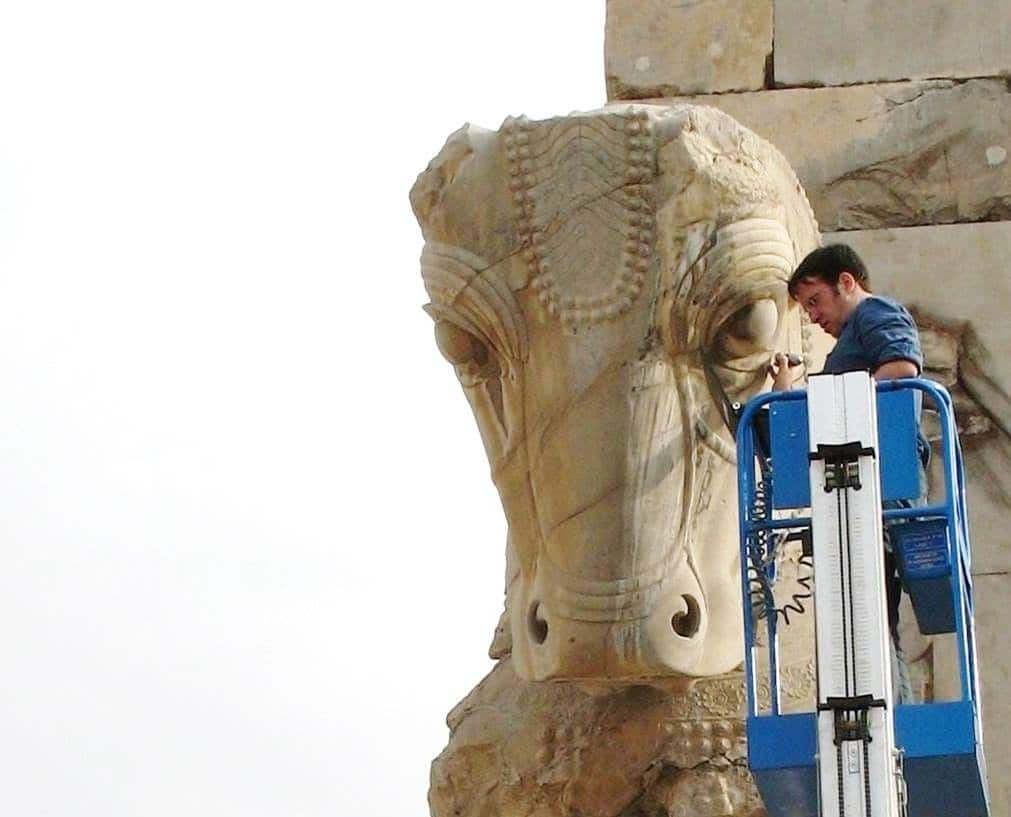
In the last century, a group of American orientalists from Chicago began restoration work in 1930. During their excavation, they were able to discover the cuneiform inscription of Xerxes, indicating that the structure was indeed the Queen’s Palace.
Afterward, German archaeologist Erich Schmidt conducted excavations in 1935, focusing on the Royal Treasury Building and the Hundred Columns Palace.

He reinforced the foundations of the columns in the Apadana Palace, restored the columns in the Bara-am Palace, and repaired part of the brick walls of various palaces. Erich Schmidt’s activities in Shiraz continued until 1940, during which he successfully discovered valuable historical artifacts in the remains of Persepolis.
Read More





Dear writer persepolis is in marvdasht city
But you write is in shiraz please correct your information